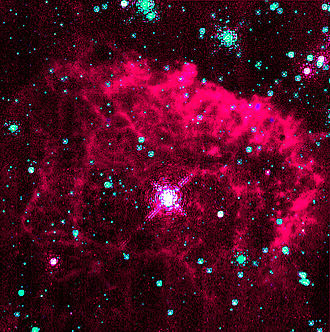| Observation data Epoch J2000 Equinox J2000 | |
|---|---|
| Constellation | Sagittarius |
| Right ascension | 17h 46m 15.3s [1] |
| Declination | −28° 50′ 04″ [1] |
| Apparent magnitude (V) | >28 [2] |
| Characteristics | |
| Spectral type | LBV [2] |
| Apparent magnitude (J) | 11.828 [1] |
| Apparent magnitude (H) | 8.920 [1] |
| Apparent magnitude (K) | 7.291 [1] |
| Variable type | cLBV [3] |
| Astrometry | |
| Radial velocity (Rv) | +130 [2] km/s |
| Distance | 7,700 [4] pc |
| Details | |
| Radius | 420 [5] [a] R☉ |
| Luminosity | 3.3 million [5] [6] L☉ |
| Temperature | 11,800 [7] –12,000 [5] K |
| Metallicity [Fe/H] | 0.1 [8] dex |
| Age | ~4 [9] Myr |
| Other designations | |
| V4647 Sgr, qF 134, 2MASS J17461524-2850035 | |
| Database references | |
| SIMBAD | data |
The Pistol Star (or V4647 Sagittarii) is an extremely luminous blue hypergiant star, one of the most luminous and massive known stars in the Milky Way. It is one of many massive young stars in the Quintuplet Cluster in the Galactic Center region. The star owes its name to the shape of the Pistol Nebula, which it illuminates. It is located approximately 25,000 light-years from Earth in the direction of Sagittarius. The star has a large mass comparable to V4998 Sagittarii and a luminosity 3.3 million times that of the Sun (L☉). It would be visible to the naked eye as a 4th-magnitude star if it were not for the interstellar dust near the Galactic Center of the Milky Way that absorbs almost all of its visible light.



